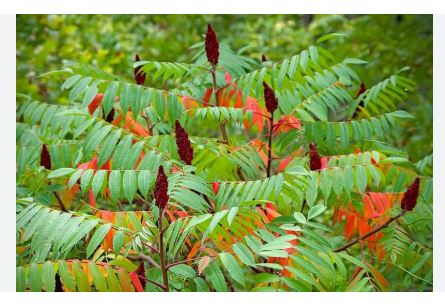
Staghorn Sumac (Rhus typhina) belongs to the family Anacardiaceae, which includes other notable plants like poison ivy and mango. It is classified within the genus Rhus, known for its sumac species. The species name “typhina” refers to its velvety, hairy branches, reminiscent of a stag’s antlers.
Native to eastern North America, Staghorn Sumac can be found from Quebec to Ontario in Canada, extending southward through the eastern United States as far as Georgia and Alabama. It thrives in various habitats, including open woodlands, along roadsides, and in disturbed areas where it can form dense thickets.
Historically, Native American tribes utilized Staghorn Sumac for medicinal purposes, with its berries used to make a tart drink or tea, valued for its high vitamin C content. The plant has also been used for tanning leather and as a natural dye. In European history, sumac was introduced as an ornamental plant, and its berries have been used in Middle Eastern cuisine for centuries, although this refers more often to Rhus coriaria.
Staghorn Sumac is a deciduous shrub or small tree that can grow up to 20 feet tall, though typically it’s shorter. It’s noted for its pinnately compound leaves, which can turn brilliant shades of red, orange, and yellow in the fall. The plant produces large, conical clusters of red, fuzzy drupes in late summer, which persist into winter, adding interest to the landscape. Its branches have a velvety texture, giving it the “staghorn” moniker.
This sumac species is hardy in USDA Zones 3 through 8, showcasing its ability to tolerate cold winters and hot summers, making it adaptable to a wide range of climates across North America.
With proper conditions, Staghorn Sumac can live for several decades, often reaching 30 to 50 years or more. Its life can be extended by its ability to spread through suckers, creating colonies that persist over time.
Landscape Uses
Staghorn Sumac is valued in landscaping for several reasons:
- Ornamental Value: Its spectacular fall foliage and persistent berry clusters make it a focal point in autumn and winter landscapes. The plant’s unique texture and form also provide year-round interest.
- Erosion Control: Its extensive root system helps stabilize soil on slopes, making it useful for erosion control in naturalistic or conservation landscapes.
- Wildlife Attraction: The berries are a food source for many bird species, while the plant offers shelter for wildlife, enhancing local biodiversity.
- Screening: It can be used as a natural screen or barrier due to its ability to form dense thickets, providing privacy without the need for constant maintenance.
- Restoration Projects: Staghorn Sumac is often planted in areas needing ecological restoration, particularly in disturbed or reclaimed sites where it can quickly colonize and improve soil conditions.
- Xeriscaping: Its drought tolerance makes it suitable for low-water landscapes, contributing to sustainable garden designs.
Staghorn Sumac (Rhus typhina) Cultivation
Choosing the Right Location:
Select a spot in your garden that receives full sun to partial shade. Staghorn Sumac performs best with at least six hours of direct sunlight, which will enhance its fall color and growth vigor.
Soil Type
This plant is not fussy about soil, thriving in well-draining, poor, sandy, or even rocky soils. It’s adaptable to a range of pH levels but prefers slightly acidic to neutral conditions.
Planting Staghorn Sumac
The best times for planting are spring or fall. Dig a hole twice as wide as the root ball but no deeper. Place the plant in the hole, ensuring the root collar is level with the soil surface, then backfill and water well.
Watering Needs
Provide regular watering to establish new plants, but once established, Staghorn Sumac is drought-tolerant. Water deeply during extended dry periods, but avoid waterlogging, as this can lead to root rot.
Spacing Considerations
Plant these sumacs at least 10 to 15 feet apart to allow for their mature spread. Consider their ability to spread via suckers, which can form thickets if not managed.
Mulching
Mulch around the base of the plant to help retain soil moisture, regulate soil temperature, and reduce weed growth. Use organic mulch like wood chips, but ensure it doesn’t touch the trunk to prevent bark decay.
Pruning Techniques
Pruning isn’t always necessary but can be done to shape the plant or control its size. Prune in late winter or early spring before new growth begins. Remove dead or diseased branches and, if desired, control suckering by cutting back new shoots.
Fertilizer Use
Fertilization is generally not required as Staghorn Sumac thrives in nutrient-poor soils. If growth seems stunted, apply a balanced, slow-release fertilizer in early spring, but sparingly to not encourage too much vegetative growth at the expense of root development.
Pest and Disease Control
Staghorn Sumac is relatively pest and disease-resistant. However, keep an eye out for aphids or scale insects. Fungal diseases like powdery mildew can occasionally appear; promote good air circulation to prevent this.
Propagation Methods
Propagate through seeds, which need cold stratification for germination, or by taking hardwood cuttings in late fall. Suckers can also be dug up and transplanted to new locations.
Managing Spread
The plant’s aggressive suckering can lead to unwanted spread. Use root barriers or regularly remove suckers to control its growth, particularly in smaller or more formal garden settings.
Winter Protection
While Staghorn Sumac is hardy in its appropriate USDA zones, young plants or those in very exposed sites might benefit from additional winter protection. A layer of mulch can insulate the roots, and in extremely cold climates, burlap wrapping around the main stem might prevent winter burn.